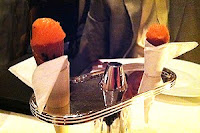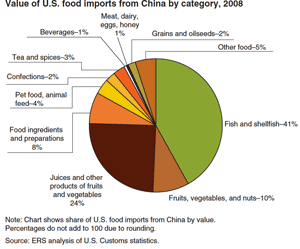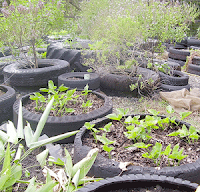Synopsis: World renown 5 star restaurant is a once in a lifetime experience--around 14 courses of exquisitely prepared miniature dishes that please the eye and palate. Pair light wines like champagne or Pinot as the flavors are delicate.
Once a laundry, saloon and brothel, now a world-renown restaurant, The French Laundry was founded in 1994 by Chef Thomas Keller in Yountville, Napa Valley. Chef Keller was named "America's Best Chef" by Time magazine and "Chef of the Year" by the Culinary Institute of America plus he won consecutive "Best Chef" awards from the James Beard Foundation. Naturally, The French Laundry is at the top of any foodie's "bucket" list, so I was thrilled that we had reservations after several years of trying to obtain one without success. I must not have been the only first time customer apprehensive about what to expect at this venerable establishment, since The French Laundry website even has a page entitled "What To Expect" where they say "...that's how we try to welcome you--as a guest in a home we love".
Indeed, the place looks more like a home that a famous building, with their sign nearly hidden in the foliage in front. We were early for our 5:30 reservation, so we peeked into the kitchen while we waited for the front door to open. A bevy of chefs were prepping in an immaculate but not ostentatious kitchen. We were welcomed into the restaurant, which continued the theme of modesty with its simple decor. The room was lit with candles and soft light, with comfortable chairs and quality place settings and stemware, but there is nothing pretentious or stuffy about the atmosphere. The feeling is one of warmth and welcome.
We had downloaded and perused the wine list prior to arriving and had decided that wines by the glass would give us a more affordable way to try a number of different selections. The French Laundry wines by the HALF bottle range from $45 to $1,285. We found wine by the glass that fit our more modest budget: the Weegmüller "Haardter Herzog" Kabinett Riesling and the Pierre-Yves Colin-Morey "Les Vireuils" white Burgundy which we thought had an off-taste and exchanged for the HdV "Hyde Vineyard" Chardonnay from Carneros. One can choose between the regular Chef's Tasting Menu and the Tasting Of Vegetables--we had one of each.
Prior to our first course, we were brought two tiny (about 1" wide) warm gougeres filled with melted cheese--fantastic! Then, two tiny "ice cream cones" of salmon tartare. I unobtrusively took photos at our corner table with my iphone--the light was dim, so the photos are not the best. The salmon cones look large--but they were about 2" tall--just a bite of salmon with a cream interior and crispy shell. Our first courses of the menu were Baked Sierra Beauty Apple for me--reminiscent of an apple betty--and "Oysters and Pearls" for Paul, which was a creamy mixture of tapioca, caviar and oysters--one of the evening's best dishes.
Next on the vegetable tasting for me was the Salad of Hachiya Persimmon with heirloom beets and petite greens. The greens were precious--one tiny sprig was the size of half my pinkie fingernail. I liked the sweet persimmon, but the beet slivers were about the size of a slivered almond, so it was difficult to taste their natural rich flavor. Paul's salad was the Salsify "En Feuille de Brick", also with the tiniest bits of salsify, Asian pear, radicchio, walnuts and radicchio. The flavors were lovely but delicate and would have been better with a brut champagne or dry sparkling wine, even though I loved the nectar-like aromatics of the Riesling.
We switched to a glass of the Maume Gevrey-Chambertin "En Pallud" from Burgundy (a Pinot Noir) and a glass of the Hirsch "San Andreas" Pinot Noir from Sonoma Coast to go with the Celeriac "Gratin", which had a nice creamy sauce that went well with the chestnuts in the dish, and the Sautéed Fillet of New Zealand Medai which had chorizo and piquillo peppers spicing it.
Paul's next course was a deconstructed "Caesar Salad" with tender lobster "mitts" and a few wisps of romaine. The photo make it look large, but it was in fact a gem-like square about 2" wide plated in the middle of a very large white plate. It comprised a tasty two bites of lobster with a hint of garlic and butter.
I had the Garnet Yams "En Cocotte" --a vegetable lover's delight. I was thrilled to see the humble yam given formal tableside service usually reserved for fish or meat. A cart was wheeled to our table with several covered silver dishes. One was opened to reveal Savoy cabbage chiffonaded and gently cooked. It was carefully spooned into the serving dish. Another silver lid was lifted to reveal the yams that had been baking in maple syrup--they were placed on the cabbage, topped with tiny Candy Cap mushrooms, then soaked with the bourbon maple syrup sauce. This was another of the evening's top dishes and paired perfectly with Pinot Noir.
Paul's next two meat courses were the Salmon Creek Farm Pork Belly and Snake River Farms "Calotte De Boeuf Grillée" which he declared delicious. My Niçoise Olive "Garganelli" had tubular pasta made from special eggs flown in from Japan. Unfortunately, I could not taste the difference and it seemed a shame to have spent the money for such an expensive ingredient when a locally raised organic egg surely would have made an excellent pasta. I also thought the pasta was a little too "al dente" and this was the only non-dessert dish I was served that I did not devour in its entirety.
The "St Nectaire" was a carefully composed combination of wilted radicchio, truffled bread bits and a prune puree that had less flavor than I would have expected from the name and the listing of ingredients.
However, the next four courses were the gastronomic equivalent of the end of a fireworks show when all guns are fired for a grand finale. Despite the tiny servings, the number of dishes we had already consumed had already sated us--but the desserts were irresistible. Sorbets were served to cleanse our palate--sour cherry or buttermilk. My buttermilk sorbet was just a spoon's worth, but it was all that was needed. Imagine the brightest, cleanest, freshest taste of dairy hitting your mouth with a flash of cold, then melting away instantly like a snowflake!
The "Pecan Pie" With Verjus-Poached Honey Pears was the perfect amount of sweetness loaded with pecan flavor. Our dessert course was quickly followed by extra treats--warm, fresh miniature donuts, macadamia nuts rolled in chocolate, chocolate truffles with various fillings and an unbelievably delicious "caffe fredo" which was a tiny cup with frozen coffee cream topped with an airy mixture that looked like steamed milk but must have been the lightest foam of meringue. We had been asked about any allergies at the beginning of the meal and I mentioned that I didn't eat chocolate, so I wasn't served the chocolate soufflé--there was no need at this point as I could not have had another bite, no matter how delicious.
For wines to pair with the dessert courses, we chose the Oremus Tokaji Aszú 5 Puttonyos and the D'Oliveira Verdelho "Reserva" Madeira--two types of wines we had never tried. I remember my wine class teacher in Culinary School Antonio Gardella rhapsodizing over Hungarian wines and saying that though they are rare in the US, they historically have been considered in Europe as being on a par with French grand cru, so I was very interested in trying the Tokaji Aszú. The grapes are allowed to contract Botrytis cinerea or "noble rot" which concentrates the flavor. The Tokai was lusciously sweet and aromatic as nectar. The Madeira was smoky and woody and did not pair as well with the desserts. Overall, if I could redo our wine choices, I think I would choose a dry champagne for the savory dishes since the flavors were so delicate. Some of the ingredients are served in such tiny amounts, that their flavors were diminished. The sauces were exquisite, but none were strongly flavored. Even the meat dishes would not pair well with a powerful red like a Cabernet Sauvignon as the decisively tasty meat portions were around 2" long and the other parts of the dish prepared with a light touch. I think the Pinot Noir we had paired was as strong a red wine as could be paired successfully with the meal we had. The one exception was the yam dish which was the most powerfully flavored dish and was perfect with our Pinot.
Besides the beautifully prepared food, the French Laundry experience was remarkable for the service. The servers silently and unobtrusively place and remove utensils and plates. We witnessed the graceful choreography as they served all the diners at the adjoining table of eight simultaneously without any fanfare or superfluous movements. Our waiter was knowlegeable and affable, happy to answer our many questions, plus he gave us a copy of the day's menu which is below, plus little bags of yummy shortbread cookies.
However, The French Laundry will have to be third on the list of the best dining experiences in my life behind the two kaiseki meals I had in ryokans in Japan: the Hiiragiya Ryokan in Kyoto and the Kankaso Ryokan in Nara. Multiple courses are served to you in your room, each presented on a priceless dish--an heirloom pottery bowl, a gilt enameled plate, a gorgeous natural stone, an elaborate laquered tray hundreds of years old--and the composition of the food creates a piece of art that complements the serving dish and reflects the season of the year. The tastes are carefully orchestrated to encompass all varieties of cooking techniques, textures, flavors and colors creating an amazing variety in the dining experience. Obviously, the quality of ingredients and technique at The French Laundry are the very best, but the texture of the dozens of ingredients in the savory dishes tended to be the same softness as if everything had been cooked sous vide. The fresh greens that garnished many dishes were so miniature that their texture was barely discernible. That note aside, we had a wonderful meal (which took around three hours to experience) and a once-in-a-lifetime taste of the virtuosity of one of the world's best Chefs.
 |
| The French Laundry |
 |
| Salmon Tartare |
We had downloaded and perused the wine list prior to arriving and had decided that wines by the glass would give us a more affordable way to try a number of different selections. The French Laundry wines by the HALF bottle range from $45 to $1,285. We found wine by the glass that fit our more modest budget: the Weegmüller "Haardter Herzog" Kabinett Riesling and the Pierre-Yves Colin-Morey "Les Vireuils" white Burgundy which we thought had an off-taste and exchanged for the HdV "Hyde Vineyard" Chardonnay from Carneros. One can choose between the regular Chef's Tasting Menu and the Tasting Of Vegetables--we had one of each.
 |
| Salad Of Hachiya Persimmon |
 |
| Celeric "Gratin" |
 |
| "Caesar Salad" |
 |
| Garnet Yams "En Cocotte" |
 |
| Salmon Creek Farm Pork Belly |
 |
| "Calotte De Boeuf Grillée" |
 |
| "St Nectaire" |
 |
| "Pecan Pie" |
 |
| Buttermilk Sorbet |
 | |
| Desserts |
Besides the beautifully prepared food, the French Laundry experience was remarkable for the service. The servers silently and unobtrusively place and remove utensils and plates. We witnessed the graceful choreography as they served all the diners at the adjoining table of eight simultaneously without any fanfare or superfluous movements. Our waiter was knowlegeable and affable, happy to answer our many questions, plus he gave us a copy of the day's menu which is below, plus little bags of yummy shortbread cookies.
However, The French Laundry will have to be third on the list of the best dining experiences in my life behind the two kaiseki meals I had in ryokans in Japan: the Hiiragiya Ryokan in Kyoto and the Kankaso Ryokan in Nara. Multiple courses are served to you in your room, each presented on a priceless dish--an heirloom pottery bowl, a gilt enameled plate, a gorgeous natural stone, an elaborate laquered tray hundreds of years old--and the composition of the food creates a piece of art that complements the serving dish and reflects the season of the year. The tastes are carefully orchestrated to encompass all varieties of cooking techniques, textures, flavors and colors creating an amazing variety in the dining experience. Obviously, the quality of ingredients and technique at The French Laundry are the very best, but the texture of the dozens of ingredients in the savory dishes tended to be the same softness as if everything had been cooked sous vide. The fresh greens that garnished many dishes were so miniature that their texture was barely discernible. That note aside, we had a wonderful meal (which took around three hours to experience) and a once-in-a-lifetime taste of the virtuosity of one of the world's best Chefs.
c h e f ’ s t a s t i n g m e n u | 2 8 De c e m b e r 2 0 1 1
PRIX FIXE 270.00 | SERVICE INCLUDED
6640 WASHINGTON STREET, YOUNTVILLE CA 94599 707.944.2380
_______________________________________
“OYSTERS AND PEARLS”
“Sabayon” of Pearl Tapioca with Point Reyes Oysters and White Sturgeon Caviar
ROYAL OSSETRA CAVIAR
Maine Sea Urchin, White Truffle, Sicilian Pistachio and “Sablé”
( 50.00 supplement )
_______________________________________
SALSIFY “EN FEUILLE DE BRICK”
Asian Pear, Tardivo Radicchio, Black Walnuts and Mizuna
MOULARD DUCK “FOIE GRAS AU TORCHON”
Honey-Glazed Cranberries, Pecans, Oxalis and Black Winter Truffle
( 30.00 supplement )
_______________________________________
SAUTÉED FILLET OF NEW ZEALAND MEDAI
Chorizo, Littleneck Clams, Piquillo Peppers, Spanish Capers and Saffron “Nuage”
“ST. PIERRE AVEC MOUSSE AU CRABE”
Petite Onions, Nantes Carrots, Tokyo Turnips and “Sauce Bordelaise” ( serves two )
_______________________________________
“CAESAR SALAD”
Sweet Butter-Poached Maine Lobster “Mitts,” Caramelized Romaine Lettuce, Garlic Melba and “Bottarga di Muggine”
_______________________________________
SALMON CREEK FARM PORK BELLY
Young Fennel, Ruby Red Grapefruit, Sunchokes and Niçoise Olives
FOUR STORY HILL FARM “CUISSE DE POULARDE”
French Laundry Garden Cabbage, Pomegranate, K&J Orchard Chestnut and Black Truffle
_______________________________________
SNAKE RIVER FARMS “CALOTTE DE BOEUF GRILLÉE”
“Pommes Darphines,” Chanterelle Mushrooms, Petite Radish, Red Ribbon Sorrel and Green Peppercorn Sauce
_______________________________________
“VERMONT SHEPHERD”
Baby Beets, Celery Root and Piedmont Hazelnuts
_______________________________________
SOUR CHERRY SORBET
Coconut “Petit Beurre” and Vanilla “Soda”
_______________________________________
ALPACO “MOUSSE AU CHOCOLAT”
Spice Pudding, “Panna Cotta,” Fuyu Persimmon and Marcona Almond “Glacée”
“POMMES ANNA”
Funnel Cake, “Pruneaux d’Agen,” Rum “Anglaise”
and Salted Caramel Ice Cream
_______________________________________
MIGNARDISES
t a s t i n g o f v e g e t a b l e s | 2 8 D e c e m b e r 2 0 1 1
PRIX FIXE 270.00 | SERVICE INCLUDED
6640 WASHINGTON STREET, YOUNTVILLE CA 94599 707.944.2380
_______________________________________
BAKED SIERRA BEAUTY APPLE
Granola, Garden Blossoms and Yogurt Mousse
_______________________________________
SALAD OF HACHIYA PERSIMMON
Heirloom Beets, Petite Greens and Spice “Gastrique”
_______________________________________
CELERIAC “GRATIN”
French Laundry Garden Celery, K&J Orchard Chestnuts, Gingerbread and Honey-Poached Cranberries
_______________________________________
HERB-ROASTED SALSIFY
Poached Quail Egg, Piedmont Hazelnuts, Mizuna and Périgourd Truffles
BUTTERNUT SQUASH “BISQUE”
Maine Lobster “Mitts,” Creamed Hearts of Romaine and Black Winter Truffle
_______________________________________
GARNET YAMS “EN COCOTTE”
Candy Cap Mushrooms, Savoy Cabbage, Red Walnuts and Bourbon Maple Syrup
_______________________________________
NIÇOISE OLIVE “GARGANELLI”
Cavolo Nero, Jingle Bell Peppers, Spanish Capers, Pine Nuts and Garlic Confit
VIDALIA ONION “RISOTTO”
Hobbs’ Bacon, Nantes Carrots, Shallots,
Scallion Salad and Port Wine Reduction
_______________________________________
“ST. NECTAIRE”
Black Truffle “Pain Perdu,” Tardivo Radicchio, “Pruneaux d’Agen” and Sicilian Pistachios
“WELSH RAREBIT”
Cabot “Clothbound Cheddar,” Cauliflower Florets and Bitter Ale Béchamel
_______________________________________
BUTTERMILK SHERBET
Oregon Huckleberries and Marcona Almond “Waffle”
_______________________________________
COEUR DE GUANAJA CHOCOLATE “SOUFFLÉ”
Banana Ice Cream and Burnt Lemon-Caramel Sauce
_______________________________________
“PECAN PIE”
Verjus-Poached Honey Pears, Maple-Brown Butter “Gastrique” and Grains of Paradise Ice Cream
_______________________________________
MIGNARDISES

































